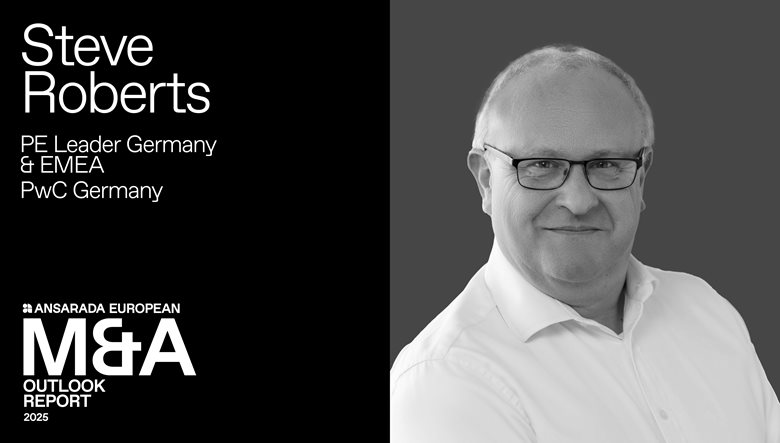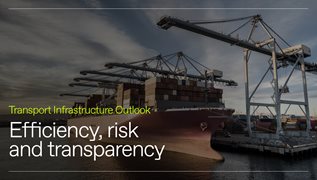PwC Germany's Steve Roberts: Drivers poised to make this a significant year for European PE deals
Steve identifies the key industries attracting private equity investment and driving deal flow.
By AnsaradaMon Jun 16 2025Mergers and acquisitions, Industry news and trends, Innovation

In this excerpt from our 2025 European M&A Outlook Report, which features insights from 12 leading European dealmakers, Steve Roberts, PE Leader Germany and EMEA at PwC Germany, delves deep into private equity (PE), discussing the opportunities, challenges and drivers that could make 2025 a big year for the market.
What is the outlook for European PE activity between now and the end of 2025?
We have seen a clear decrease in the number of deals taking place over the past few years. One major factor has been a lack of available financing, which stopped PE activity dead in its tracks. Inflationary pressures served to widen the gap of seller and purchaser price expectations, meaning that companies have been standing still in pure monetary terms and exit value. While the markets have now absorbed the inflation and managed to keep their lights on, we are still left with this expectation gap.
On the other side, fundraising has reached record levels over recent years and dry powder is off the charts. It is steadily increasing yet is not being deployed at the same rate. LPs are being more selective in terms of where they deploy their cash because they have only a limited allocation. What we are left with is a situation where PE professionals are sitting, waiting to deploy capital. Everybody’s waiting for the flood gates to open.
What type of sectors or assets or sub-sectors do you feel will be especially attractive for PE funds between now and the end of 2025?
Technology, media and telecommunications (TMT) – particularly technology – and healthcare continue to be top performers in terms of the number of deals taking place. Companies in the tech sector are reaching maturity following a wave of activity in the and the 2000s. There is an established and consistent pipeline of startups feeding the market, which is fuelling PE activity. A level of fragmentation in certain parts of the industry is also driving up investment.
Another major growth area is infrastructure. There is a real need for investment across the sector, and PE is the perfect solution to fill this gap. As it is an attractive long-term investment with very bankable returns, infrastructure investment works well for PE, too. It is slightly lower yield than other sectors, but it has a proven track record and is very diversified.
With the continued development of AI technology, demand for data centres is seemingly unstoppable – it is set to become a huge growth area. Yet the energy needed to power these centres and fuel the artificial intelligence (AI) boom is vast. Just a part of the US market would require data centre infrastructure the size of a small town. It would require something like 20 to 25 nuclear power stations just to power this town and feed the AI capability. Globally, it is a huge task. While generating this level energy is definitely a limiting factor to the growth of data centres, the demand is definitely there.
Is the PE pipeline busy for 2025? Is there a growing confidence in the market?
Definitely. We are very sell-side heavy in terms of what is coming down the line, and it is a trend we are seeing across the market. There is a lot of money being put up, and a lot of fees being agreed.
During a period of low deal activity, PE professionals have the time to sit with their portfolios and focus on driving value creation. They have had a couple of years to dive a bit deeper on the value creation side, which has laid the foundations for the sell-side activity we are now seeing.
There is an inevitable backlog of funds that need to be released in the first half of 2025. Across the market, everyone is gearing up to sell. While the world is not necessarily as stable as it once was, the geopolitical situation is arguably calming. With some major elections now behind us, I think a wave of deals is unavoidable. There is a pressure to exit, which is a phenomenon we have not witnessed for a long time. I would be really surprised if, once we get through to Easter and into Q2, the market is not actually quite hot.
What are the main challenges PE firms are facing in relation to due diligence?
Following new regulations such as the Corporate Sustainability Reporting Directive (CSRD), there is a greater focus on environmental, social and governance (ESG) factors influencing the deal process. With the help of AI, businesses can now see their ESG ranking compared to their global peers at the click of a button. This can both create value but can also be destructive if one is not careful.
PE investors do not want to be left behind. To get ahead, they need to focus on the sustainability of their business plans. They need to understand the business plan to a greater degree of granularity and transparency than we have seen over recent years. To do this, PE investors need to go back to their roots and emphasise value creation – their key selling point.


